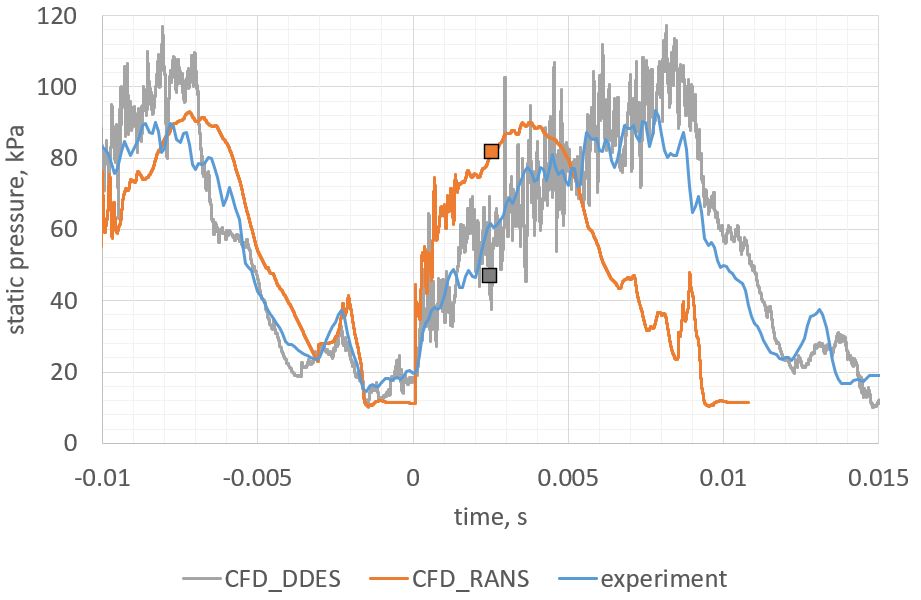Numerical investigation of the supersonic intake and wings
JAXA Supercomputer System Annual Report February 2021-January 2022
Report Number: R21ETET10
Subject Category: Skills Acquisition System
- Responsible Representative: Takashi Aoyama, Aviation Technology Directorate, Aircraft Lifecycle Innovation Hub
- Contact Information: Manami Fujii(m-fujii@moegi.waseda.jp)
- Members: Manami Fujii
Abstract
JAXA and universities have been advancing research to realize a hypersonic passenger airplane. This plan is divided into 4 stages and the 1st stage is called High-Mach Integrated Control Experiment (HIMICO). This is a hypersonic flight experiment aiming at establishing the integrated control technologies of the airframe and the engine. It is known that the supersonic intake performance can be enhanced by increasing the intake back pressure. However, the excessively high back pressure is known to induce a buzz, which is a self-excited oscillation of the shock wave. The buzz causes a severe vibration of the pressure inside the engine and can result in a misfire or a breakdown of the engine. Therefore, finding out the mechanism of the buzz and establishing the methods to suppress the occurrence are necessary. In this study, the characteristics of the buzz occurring on the intake for HIMICO is investigated numerically.
Reference URL
N/A
Reasons and benefits of using JAXA Supercomputer System
The inner flow of the supersonic intake is so complex that the calculation cost is large. However, it became possible to carry out the unsteady simulation of the intake with several turbulence models by using JSS3.
Achievements of the Year
The numerical simulation is carried out to reveal the buzz characteristics occurring on the supersonic intake for HIMICO. The several calculations are conducted using some turbulence models in order to match the results of simulation with the experimental results. The buzz frequency gained by DDES (SST-2003sust) and RANS(SST-2003) simulations are 62.1 Hz and 92.6 Hz, respectively, and the results with DDES simulation corresponds well with the experimental results (66.8 Hz). The time variation of the static pressure inside the engine is shown in fig.1. As shown in fig.1, the cause of the error in buzz frequency with RANS simulation is the shorter pressure increasing period. It is found that the rapid rise of the static pressure is caused by the separation region on the ramp generated with RANS simulation shown in fig.2. This separation region changes the Mach number distribution inside the engine and results in the rapid rise of the static pressure. Therefore, it is revealed that the type of the turbulence model greatly affects the existence of the separation region, which make large impact on the buzz characteristics, so the calculation methods must be chosen carefully.
Publications
- Oral Presentations
1) Fujii, M., Hoshiya, Y., Fujimori, Y., Sato, T., Hashimoto, A., Takahashi, T., and Taguchi, H., Effect of the Turbulence Model on the Buzz Characteristics Occurring on the Air Intake for High-Mach Integrated Control Experiment (HIMICO), AIAA ASCEND, online, AIAA-2021-4164, Nov. 2021.
2)Fujii, M., Sato, T., Hashimoto, A., Taguchi, H., Numerical Investigation on the Effect of the Airframe Angle of Attack on the Intake Performance for High Mach Integrated Control Experiment (HIMICO), The 61th Conference on Aerospace Propulsion and Power, Yonago, 3A07, Mar. 2022 (planned).
Usage of JSS
Computational Information
- Process Parallelization Methods: MPI
- Thread Parallelization Methods: N/A
- Number of Processes: 512 - 1024
- Elapsed Time per Case: 90 Hour(s)
JSS3 Resources Used
Fraction of Usage in Total Resources*1(%): 0.66
Details
Please refer to System Configuration of JSS3 for the system configuration and major specifications of JSS3.
| System Name | CPU Resources Used(Core x Hours) | Fraction of Usage*2(%) |
|---|---|---|
| TOKI-SORA | 11592905.56 | 0.56 |
| TOKI-ST | 989532.21 | 1.22 |
| TOKI-GP | 0.00 | 0.00 |
| TOKI-XM | 233.20 | 0.17 |
| TOKI-LM | 21411.81 | 1.60 |
| TOKI-TST | 0.00 | 0.00 |
| TOKI-TGP | 0.00 | 0.00 |
| TOKI-TLM | 0.00 | 0.00 |
| File System Name | Storage Assigned(GiB) | Fraction of Usage*2(%) |
|---|---|---|
| /home | 1250.00 | 1.24 |
| /data and /data2 | 76440.00 | 0.82 |
| /ssd | 10290.00 | 2.66 |
| Archiver Name | Storage Used(TiB) | Fraction of Usage*2(%) |
|---|---|---|
| J-SPACE | 0.07 | 0.00 |
*1: Fraction of Usage in Total Resources: Weighted average of three resource types (Computing, File System, and Archiver).
*2: Fraction of Usage:Percentage of usage relative to each resource used in one year.
ISV Software Licenses Used
| ISV Software Licenses Used(Hours) | Fraction of Usage*2(%) | |
|---|---|---|
| ISV Software Licenses(Total) | 4131.21 | 2.89 |
*2: Fraction of Usage:Percentage of usage relative to each resource used in one year.
JAXA Supercomputer System Annual Report February 2021-January 2022




